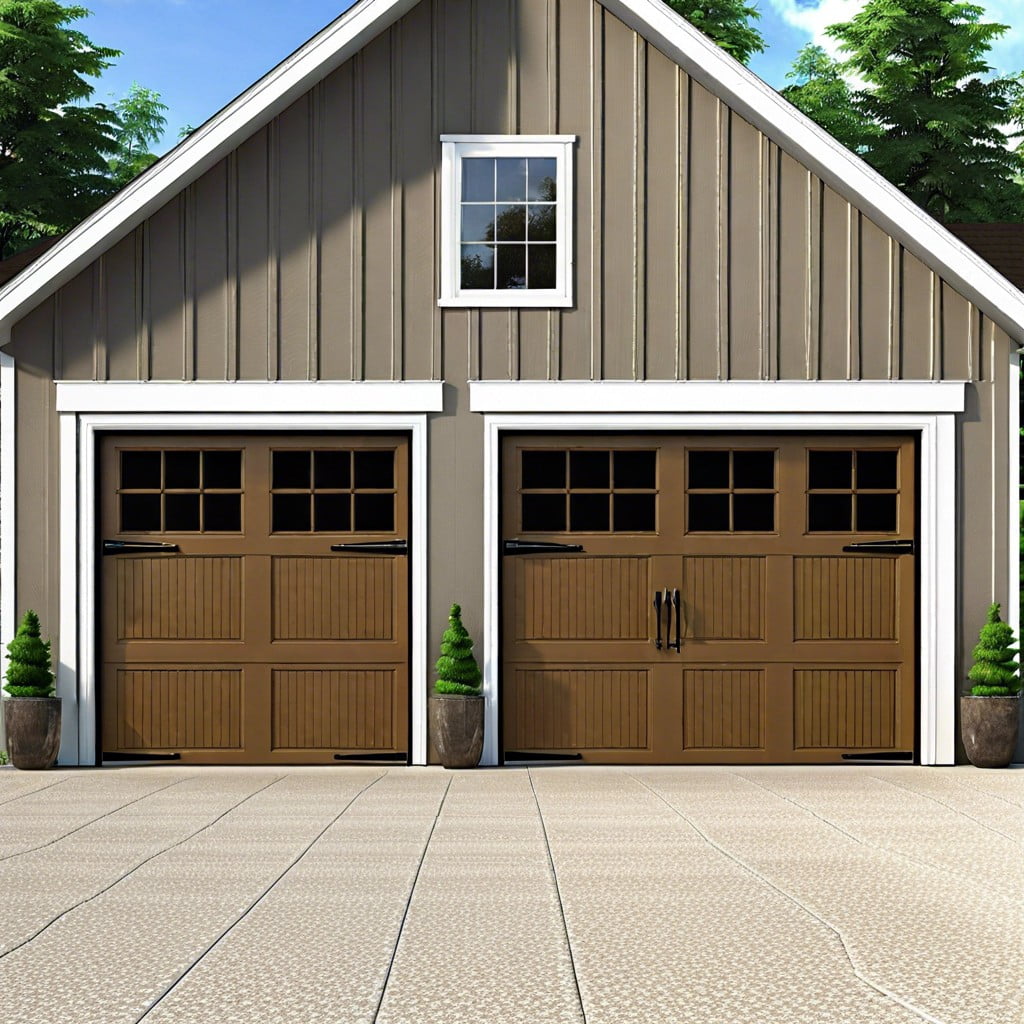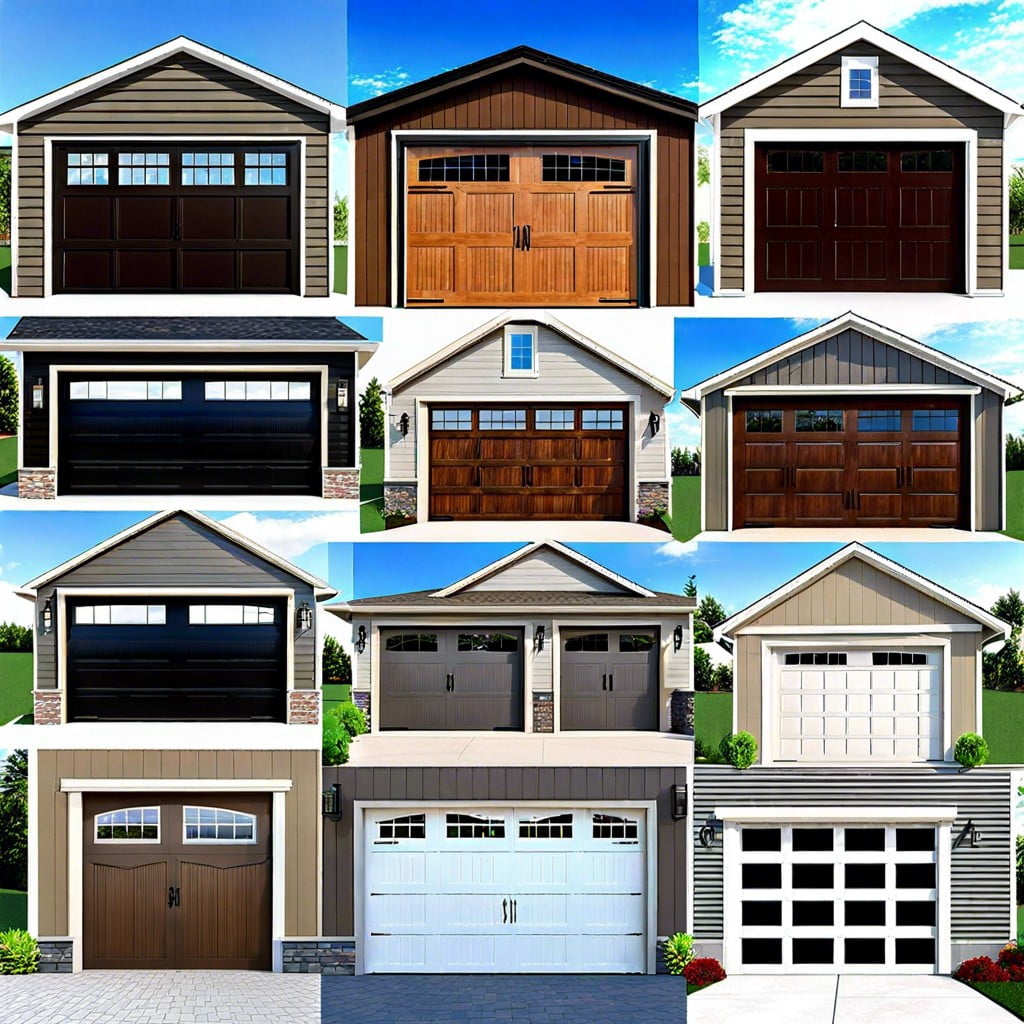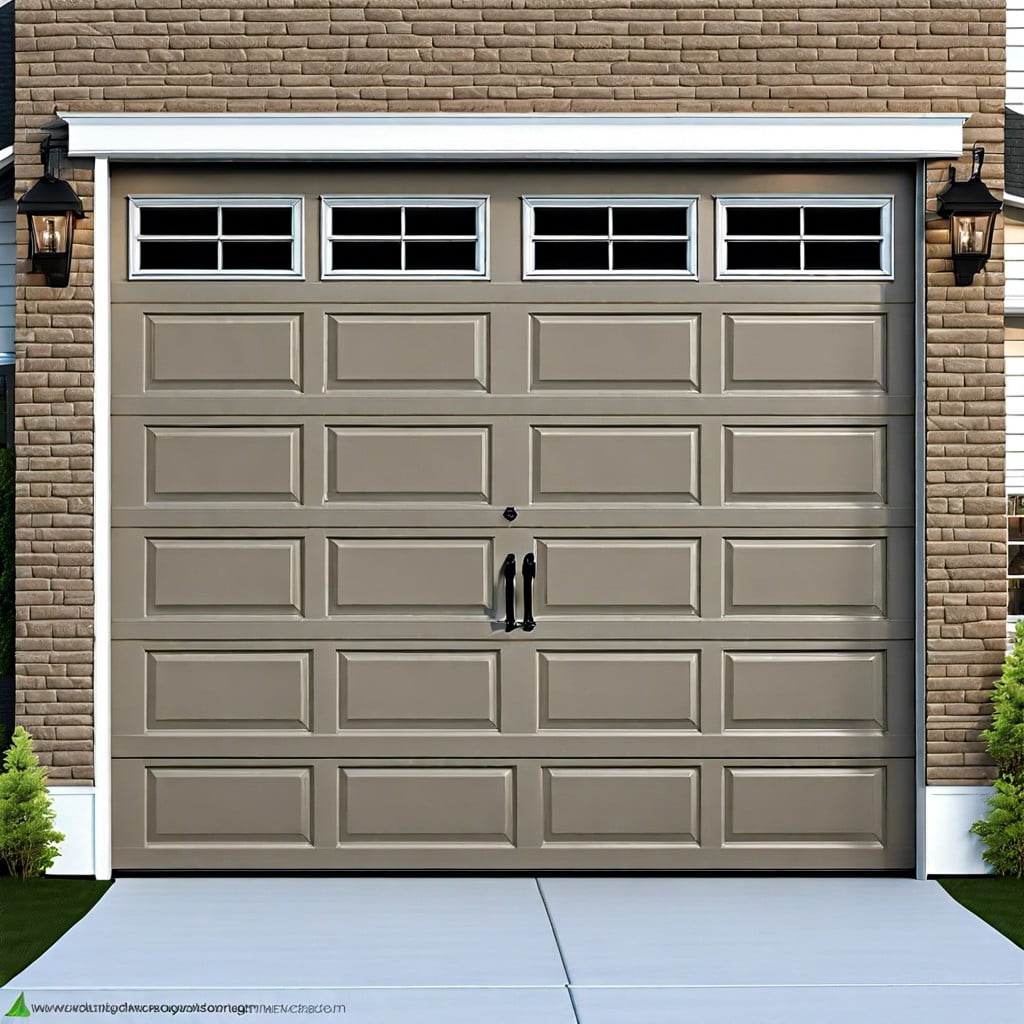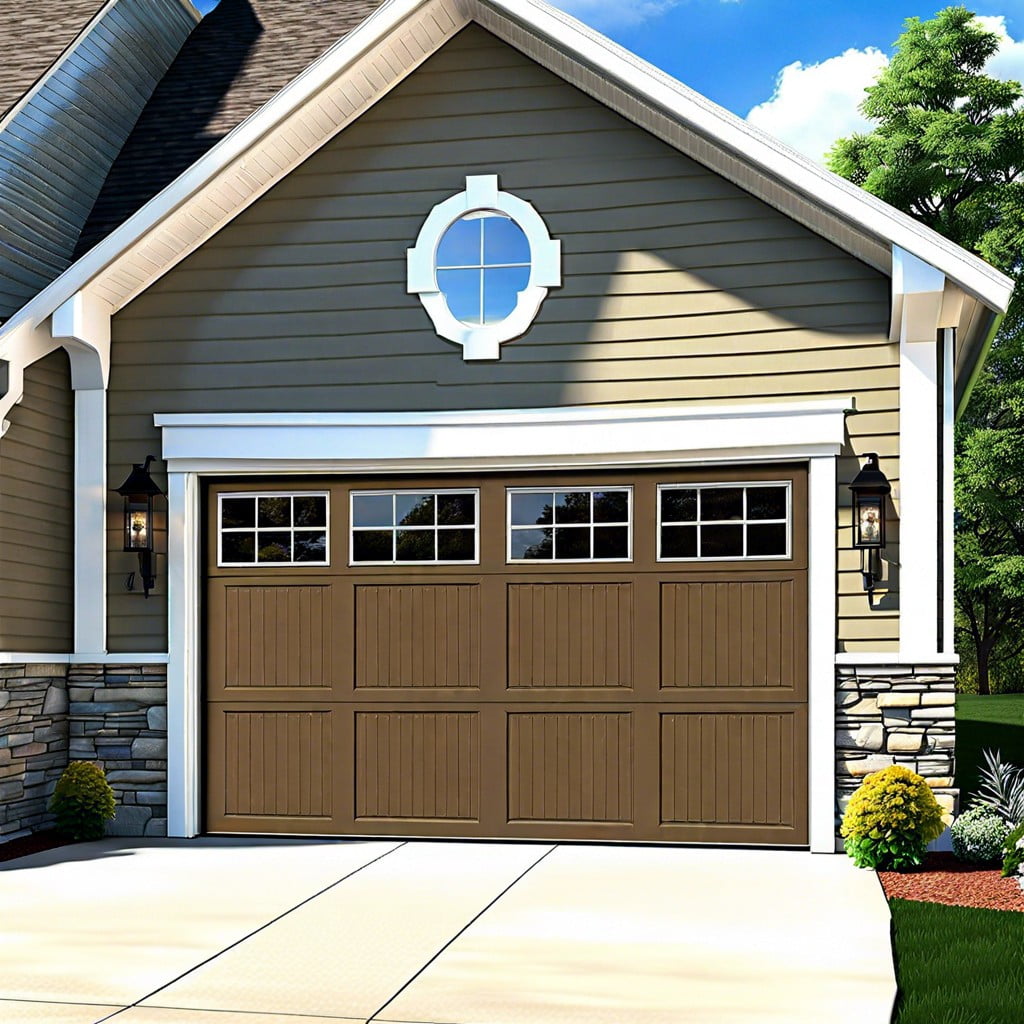Explore the advantages of a 16-foot garage door because their unique attributes might just make them the perfect solution for your garage space optimization needs.
Key takeaways:
- 16-foot garage doors are typically 16 feet wide by 7 feet tall.
- Material options include steel, aluminum, wood, composite, and glass.
- Structural requirements include a sturdy header, side jambs, spring system, level floor, and sufficient backroom and headroom.
- Insulation considerations include the door’s R-value, polystyrene, and polyurethane insulation.
- Aesthetic and design choices include various styles, materials, colors, decorative hardware, window inserts, and customizations.
Standard Dimensions of a 16-Foot Garage Door

A 16-foot garage door typically measures 16 feet wide by 7 feet tall in residential settings, providing ample space for larger vehicles or multiple car parking.
Commercial versions may vary in height, often ranging up to 24 feet to accommodate taller vehicles.
The standard thickness is usually 1 3/8 to 2 inches, depending on the door’s material and insulation properties.
Custom sizes are available, although they can substantially increase the cost.
It’s important to note that a few inches of framing on each side of the door are needed for proper installation, which should be factored into garage wall construction plans.
Material Options for 16-Foot Garage Doors

Steel is a popular choice due to its durability, low maintenance, and range of styles. It can be insulated to improve energy efficiency and is often the most cost-effective option.
Aluminum offers a lightweight alternative, resisting rust and corrosion better than steel. It tends to be pricier but is ideal for wider doors as it places less strain on operating mechanisms.
Wood provides a classic look and can be customized to fit any aesthetic. It requires more upkeep to protect against elements but is unmatched in its natural beauty.
Composite materials, like fiberglass or vinyl, mimic wood grain while offering increased resistance to denting, cracking, and warping. Their lightweight nature eases the load on automatic openers.
Glass panels with an aluminum frame are an ultra-modern option, bringing natural light into the garage. They are more expensive and require more maintenance but make a striking visual statement.
Structural Requirements for Installing a 16-Foot Garage Door

Before embarking on the installation of a sizable 16-foot garage door, assessing the integrity of the existing garage structure is crucial. Key structural elements to consider include:
- Header: The header is a critical support that spans the top of the garage door opening. For a door this wide, a sturdy, engineered beam capable of bearing the door’s weight and any additional loads from the roof or floors above is needed. Professional assessment is advised to determine the appropriate size and material for the header.
- Side Jambs: Side jambs run vertically on either side of the garage door opening and must be constructed from solid material to anchor the door tracks securely.
- Spring System: Due to the heavier weight associated with a wider door, a robust torsion spring system is often required. The correct spring size and tension ensure safe and efficient door operation.
- Floor Level: A level floor is important to guarantee proper door alignment and to avert operational issues. Adjustment to the concrete may be necessary for an optimal fit.
- Backroom and Headroom: Sufficient space is required behind and above the door’s pathway. The standard requirement is usually around 18 inches of headroom and the door height plus an additional 3 to 4 feet of backroom.
Consultation with a professional installer or structural engineer can ensure that these requirements are met, preventing costly adjustments post-installation and ensuring the stability and longevity of the door.
Insulation Considerations for 16-Foot Garage Doors

When evaluating insulation for expansive garage doors, reflect on the door’s R-value, a measure of thermal resistance. Higher R-values indicate enhanced insulation, yielding energy efficiency and noise reduction.
For frigid climates, a minimum R-value of 12 is advisable. Polystyrene and polyurethane are common insulation materials, with polyurethane providing a denser, more effective solution.
Insulation not only contributes to regulating temperature but also reinforces door strength and durability. Prioritize weatherstripping and sealing to prevent drafts, ensuring a consistent indoor climate.
Consult with a professional to ascertain the appropriate insulation level for your regional conditions and energy-saving goals.
Aesthetic and Design Choices for 16-Foot Garage Doors
Choosing the right aesthetic for your garage door can significantly enhance your home’s curb appeal. With a variety of styles available, such as traditional raised-panel, contemporary full-view glass, or the rustic charm of carriage house doors, there’s a design to complement any architectural theme.
Material choices like steel, wood, fiberglass, or aluminum each offer distinct looks and performance characteristics. Color options are vast, from classic whites to bold custom hues, allowing for personalization to suit your taste.
Further customize your door with decorative hardware such as handles and hinges, which can mimic a swing-out door while retaining a modern roll-up function. Window inserts are another design feature that not only adds style but also brings natural light into your garage.
For those seeking a unique touch, custom panel designs or the integration of textures and overlays, such as faux wood, can make a standard door look like a high-end architectural element. Understanding the visual impact of your choice sets the stage for a successful exterior transformation.
Cost Range for Purchasing and Installing a 16-Foot Garage Door
Prices for a 16-foot garage door vary significantly depending on material, insulation, and style. Basic, non-insulated steel doors may start around $750, while mid-range insulated doors often cost between $1,200 and $2,000. For high-end options with custom designs or premium materials such as solid wood, the price can surge to $3,000 or more.
Installation costs also fluctuate based on labor rates and the complexity of the job, typically ranging from $200 to $500. Ultimately, the total expenditure is influenced by additional features such as windows, hardware, and the inclusion of a garage door opener. When budgeting, remember to account for potential extra costs like removing the old door or structural modifications.
Always seek multiple quotes for a comprehensive perspective on the expense involved.
Maintenance Tips for 16-Foot Garage Doors
Regular maintenance ensures longevity and smooth operation. Below are essential steps to keep your door in top condition:
- Lubricate moving parts annually with a silicone-based lubricant to prevent grinding or squeaking.
- Inspect springs and cables for wear or damage; replace as needed to avoid breakage that could lead to injury or further damage to the door system.
- Check for loose hardware, such as screws and bolts, and tighten them to ensure stability and safety.
- Clean the tracks with a soft cloth to remove debris that could disrupt movement. Avoid using harsh solvents which can corrode metal parts.
- Test the door balance by manually lifting it halfway. A properly balanced door will remain in place, signaling that the springs are functioning correctly.
- Examine weather stripping for cracks or tears and replace it to maintain insulation and protect against water damage.
- Observe the door’s operation for any inconsistencies or hitches in movement – early detection of issues can prevent costly repairs.
Implement these practices into a biannual routine for optimal performance and to forestall major complications with your 16-foot garage door.
Impact of a 16-Foot Garage Door On Home Value
A well-chosen garage door can be a significant investment in your property, yielding a positive return when it’s time to sell. Here are several factors to consider:
- Curb Appeal: A 16-foot door creates a bold frontage, potentially enhancing the visual appeal of the home and attracting prospective buyers.
- Functionality: The wider entrance makes parking larger vehicles more convenient, which can be a strong selling point.
- Energy Efficiency: If the door is properly insulated, it can reduce energy costs, a feature that’s attractive to energy-conscious buyers.
- Safety and Security: Modern 16-foot doors equipped with sturdy materials and security features can provide an extra sense of safety, which can be a value-adding aspect of your home.
- Customization: High-end or custom-designed garage doors can serve as a luxurious touch that sets your property apart in the real estate market.
When evaluating these impacts, it is essential to consider the local market standards and the target demographic. In some neighborhoods, a large, upscale garage door could be a decisive factor, while in others, the importance might be less pronounced.
Compatibility With Garage Door Openers
When selecting an opener for a 16-foot garage door, it’s crucial to ensure that the device has sufficient power to handle the door’s size and weight. Typically, a ¾ horsepower (HP) motor is recommended for this door width to operate smoothly and efficiently.
Additionally, the type of drive (belt, chain, or screw) is important to consider for durability and noise level. Belt-driven openers are quieter and well-suited for attached garages while chain-driven models are known for their strength and affordability.
It’s also vital to consider the opener’s compatibility with advanced features such as smart home integration and security enhancements. Ensuring that the chosen garage door opener meets these criteria will provide reliable performance and convenience.
Local Building Codes and Permits Related to 16-Foot Garage Doors
Before proceeding with the installation of a substantial fixture like a 16-foot garage door, it’s important to ensure compliance with local building codes and secure the necessary permits. This compliance is crucial for several reasons:
- Safety Standards: Building codes establish safety protocols that must be followed to help prevent structural failures or accidents.
- Zoning Laws: Certain areas may restrict the size or type of garage door you can install based on zoning regulations aimed at maintaining the aesthetic or historical integrity of the neighborhood.
- Permit Requirements: Obtaining a permit is often a prerequisite for new constructions or major alterations, which a 16-foot garage door may constitute. This ensures that your garage alteration is on record and has been approved by the local authorities.
- Insurance Validity: Should an accident occur related to your garage door, having followed code and permit stipulations helps ensure that insurance claims will not be denied due to unauthorized modifications.
To streamline this process:
- Contact your local building department for information on specific codes and permit requirements.
- Hire a licensed contractor who is familiar with these regulations and can help navigate the permit process.
- Consider potential delays in your project timeline for permit approval when planning the installation.
Remember, engaging with local regulations early in your project can save time, money, and legal complications, ensuring a smoother enhancement to your home.
FAQ
Is a 16 ft garage door big enough for 2 cars?
Yes, a 16 ft garage door is typically wide enough to accommodate two cars, allowing one vehicle to enter or exit while the other remains parked given sufficient clearance.
How long does it take to install a 16 foot garage door?
The installation of a 16-foot garage door typically takes between 3 to 4 hours.
What size garage door opener do I need for a 16 foot door?
For a 16 foot garage door, you need a garage door opener with a ¾ HP or 700 N motor.
What size is a 16 foot garage door?
A 16 foot garage door typically measures 16 feet in width and 7 feet in height.
What are the material options for a 16 foot garage door?
The material options for a 16 foot garage door include steel, wood, vinyl, fiberglass, and aluminum.
How much maintenance does a 16 foot garage door require yearly?
A 16 foot garage door typically requires at least two maintenance checks a year for optimal operation and longevity.
What are the safety considerations when installing a 16 foot garage door?
When installing a 16 foot garage door, safety considerations include, proper alignment, tension system balancing, and securing all fittings to avoid accidents.